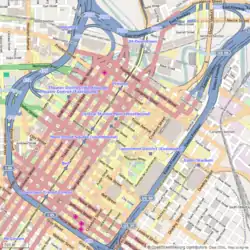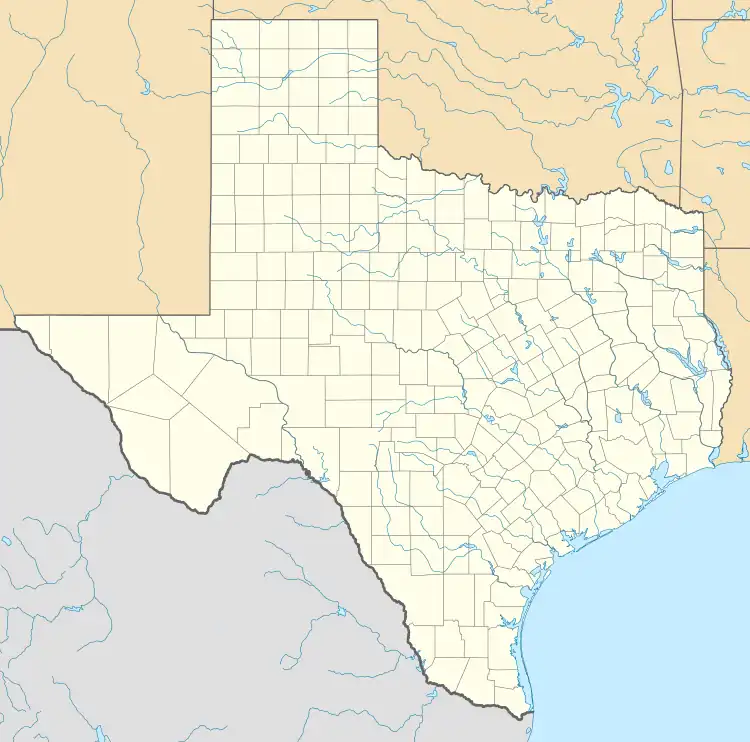Hogg Building | |
 The building's exterior in 2011 | |
   | |
| Location | 401 Louisiana Street, Houston, Texas |
|---|---|
| Coordinates | 29°45′45″N 95°21′50″W / 29.76250°N 95.36389°W |
| Area | less than one acre |
| Built | 1921 |
| Architect | Barglebaugh & Whitson |
| Architectural style | Late 19th and 20th Century Revivals, Mediterranean Revival |
| NRHP reference No. | 78002943[1] |
| RTHL No. | 10684 |
| Significant dates | |
| Added to NRHP | July 14, 1978 |
| Designated RTHL | 1981 |
The Hogg Building, also known as the Hogg Palace, is a building located at 401 Louisiana in Downtown Houston, Texas, and is listed on the National Register of Historic Places.
History
The Hogg Building was known as the Armor Building during the design process[2] and the Great Southern Building when it opened in March 1921.[3] Charles Erwin Barglebaugh and Lloyd R. Whitson of El Paso designed the eight-story, Sullivan-inspired building. The ground floor was used as a showroom for automobiles, while the other stories were dedicated to office space. It was constructed of concrete with reinforced steel, thus eliminating the need for a large number of piers. The building is also characterized by a great number of windows, covering much of the outer facing. Ornamentation marks the tops of the seventh and first floors.[2]
William Clifford Hogg, the eldest son of former Texas Governor Jim Hogg, used the eighth-floor penthouse to manage Hogg Brothers Company and the family's philanthropic projects.[3][4] In the 1920s, Hogg's workspace was, "surrounded by a roof garden lavishly abloom with shrubs and flowers, in a suite of elegantly furnished rooms that included an oval dining room, a kitchen, a living room, and a guest bedroom as well as offices."[4] He decorated the penthouse with his collection of artwork by Frederic Remington.[4][5] The Hogg family used the penthouse as a business office until 1941.[3]
In the early 1990s, developer Randall Davis converted the retail and office building into seventy-nine loft apartments.[6] Davis opened the refurbished building as the Hogg Palace Lofts in the fall of 1995, and it was already fully leased by the end of that year.[7]
See also
References
- ↑ "National Register Information System". National Register of Historic Places. National Park Service. July 9, 2010.
- 1 2 Henry, Jay C. (1993). Architecture in Texas, 1895-1945. Austin, Texas: University of Texas Press. pp. 66–67.
- 1 2 3 Kirkland, Kate Sayen (2009). The Hogg Family and Houston: philanthropy and the civic ideal. Austin, Texas: University of Texas Press. p. 28.
- 1 2 3 Bernhard, Virginia (1996). Ima Hogg: the Governor's daughter (2 ed.). New York: Brandywine Press. p. 67.
- ↑ Kirkland, p.213
- ↑ Myers, Victoria J. ("Preservation CAN work in Houston: The Humble Oil & Refining Company Building" (PDF). Vol. 6, no. 3. Houston History.
- ↑ Bivins, Ralph (December 20, 1995)."Lofty ambitions/Old Texaco offices selling to investors/Downtown building to get apartments". Houston Chronicle.
External links
- Beachy, Debra (March 15, 1998). "Historic Buildings in Houston Getting New Roles". New York Times. Retrieved November 20, 2014.
- "Armor Building". Prairie School Traveler. Retrieved November 20, 2014.
- "Hogg Palace". Houston in Pics: Houston photo blog with a pedestrian bias. Retrieved November 20, 2014.
- "The Hogg Brothers Collection". Museum of Fine Arts, Houston. Archived from the original on July 4, 2011. Retrieved November 26, 2014.
- Arthur Lefevre, Jr., "HOGG, WILLIAM CLIFFORD," Handbook of Texas Online (http://www.tshaonline.org/handbook/online/articles/fho20), accessed November 26, 2014. Uploaded on June 15, 2010. Published by the Texas State Historical Association.

